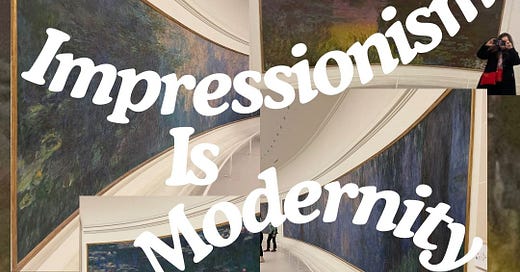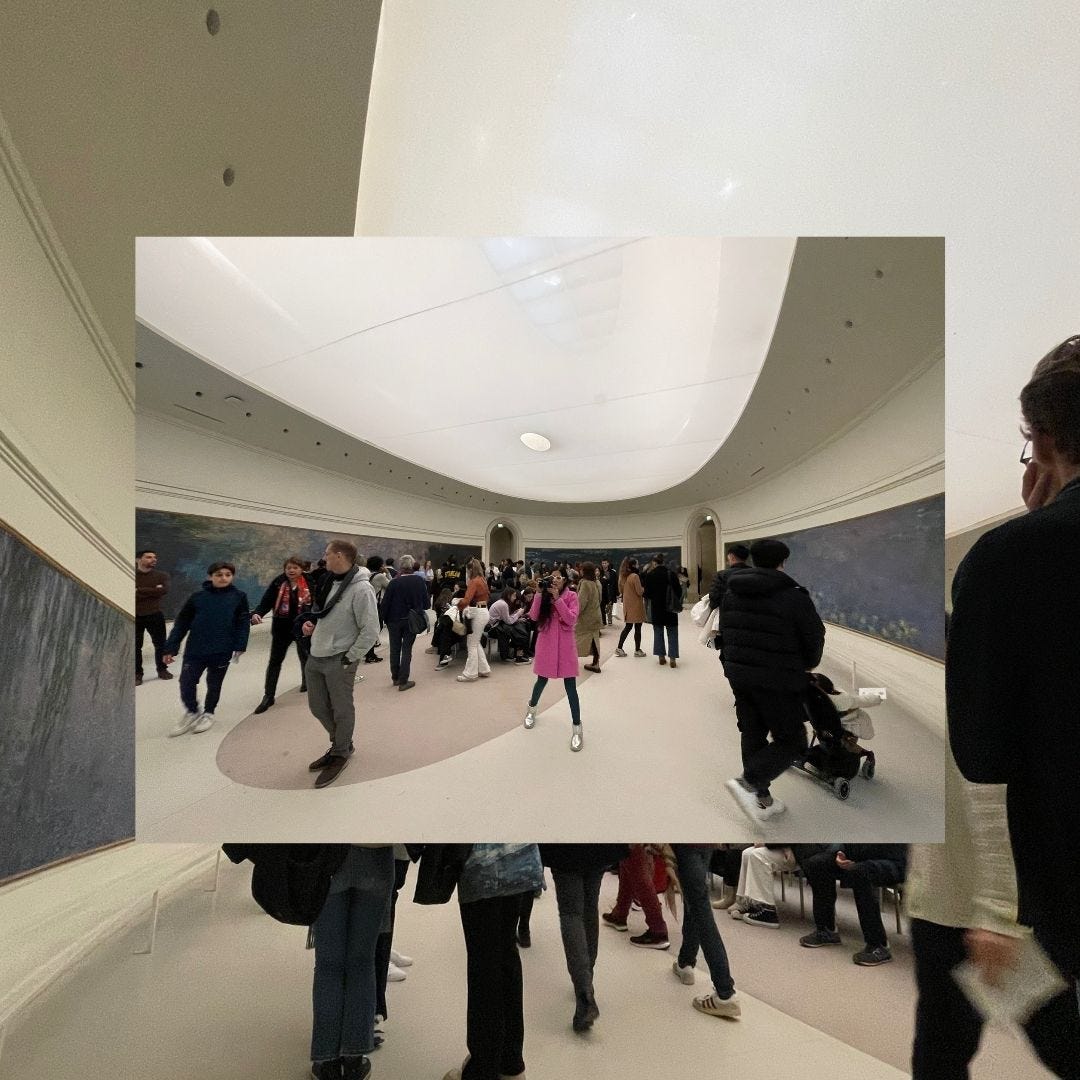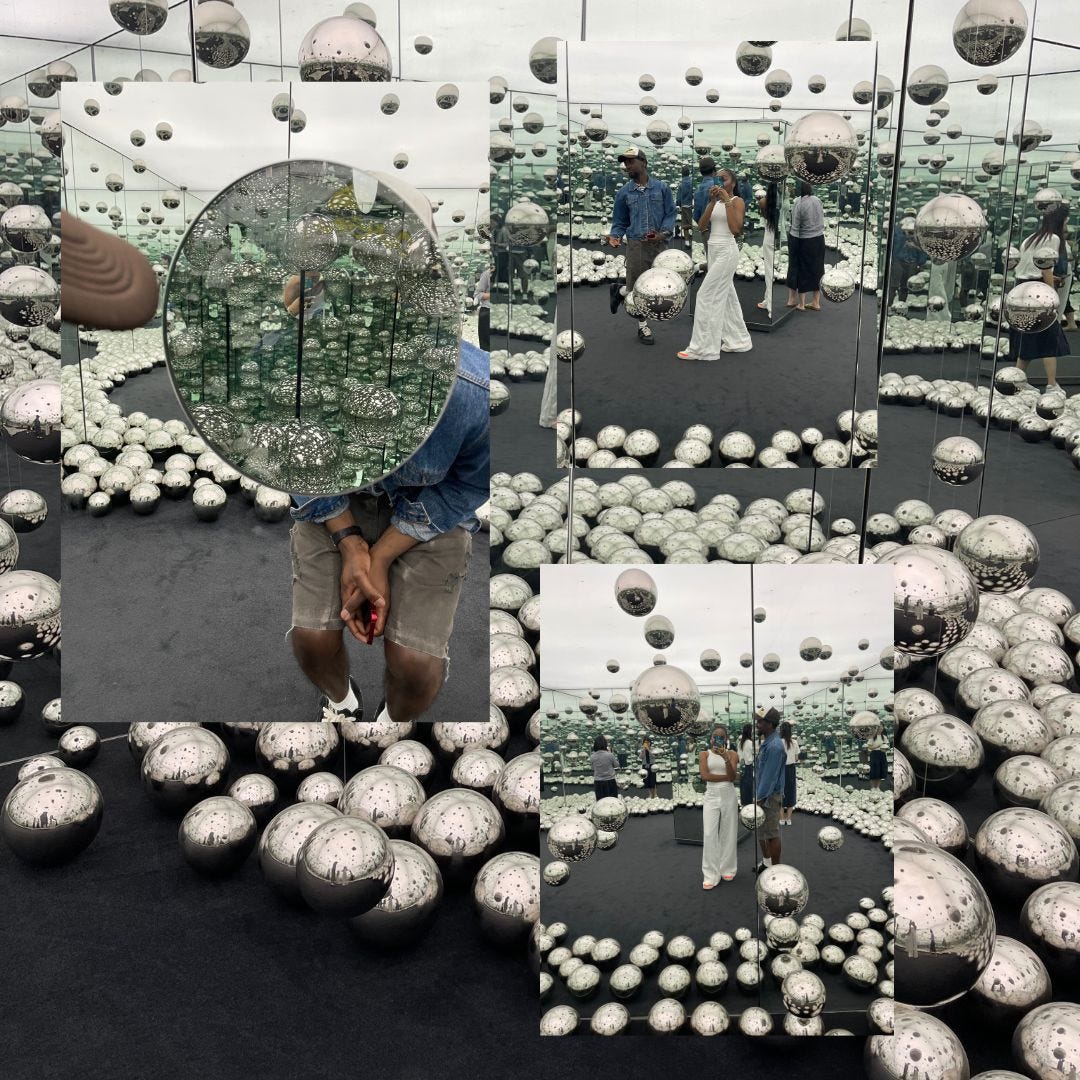Issue 6: Claude Monet; Embracing Modernity and lessons of Impressionism
In this issue, I explore Monet’s lasting impact, what his art reveals about France and artistic evolution, and why his Impressionist vision continues to resonate today.
In Issue 2, The Art of Looking and Becoming, I talk about how my love for art came about (if you haven’t read it, I highly encourage you to!). I recount my first encounter with Monet’s work in an art history class I took during undergrad and explain how no art form exists in isolation because of cultural exchange. In the course The Visual Art Today, I learned about a French artist named Claude Monet, often considered the father of Impressionism, and his works later became some of my favourite pieces to seek out whenever I visited a museum or art gallery.
In this week’s post, I want to bring you into my world of encountering, flowing with, and learning about Monet’s work. I’ll explore how his painting style created the Impressionist movement and its impact on art today, why his works resonate with me, and how the very act of looking plays a significant role in consuming modern, contemporary, and all forms of art. And, as I try to do in every post, I will connect it back to culture and development, examining what his works teach us about France, history, and artistic evolution.
My First Encounter with Monet
In my final semester of undergrad in the fall of 2022, we explored different art eras, starting with the Renaissance era, which spanned the 14th to the 17th century and marked a significant transformation in European artistic expression. This period saw a revival of classical learning and a renewed interest in the natural world, individual expression, and human-centred themes. Then came the Rococo era, originating from France and closely associated with Neoclassicism (not to be confused with neoclassical economics, of course). This movement marked a return to classical Greek and Roman aesthetics, emphasizing order, symmetry, and idealized forms. In these eras, we were introduced to artists like Leonardo da Vinci and Michelangelo. Afterwards, several significant movements emerged, each building upon or reacting to the principles established in those earlier periods. This is where I was introduced to movements like Realism, Cubism, and, of course, Impressionism, which is characterized by capturing the visual effects of light and movement. Impressionism was one of the first in a string of avant-garde art movements that rejected tradition and embraced modernity, in essence, Impressionism celebrates modernity.
The era of Impressionism cannot be discussed without mentioning Claude Monet. Born in 1840, in Paris, Monet was a pioneering painter and is often considered the founder of Impressionism, a movement seen as a precursor to modernism. Monet sought to capture his perception of nature, especially through outdoor painting. The term "Impressionism" comes from his painting Impression, Soleil Levant (Impression, Sunrise), a title originally intended as an insult by critic Louis Leroy, who mockingly referred to the exhibition as an "exhibition of the Impressionists."
At first, when I learned about Monet and his work, I was impressed, but I didn’t feel a deep connection. Over the years, however, as I learned more about viewing and perceiving art especially after visiting the Musée d’Orangerie and being in awe of the Water Lilies, I developed a profound appreciation for his work and its impact on art today. What drew me to Monet was his masterful use of colour to convey mood and emotion, his deliberate imperfections in brushstrokes, and his refusal to adhere strictly to realism. I love how, from a distance, his work forms a cohesive image, yet up close, you can see layer upon layer of paint that transforms the scene into something almost unrecognizable. I especially appreciate how he rarely used black, instead emphasizing light and colour to capture the fleeting effects of nature on canvas. His choice to depict the natural world in its ever-changing glory speaks to those of us who are environmentally conscious and cherish nature. In many ways, his work offers a glimpse into how he experienced life as an artist in Paris from the late 1800s to the early 1900s. I adore the timeless quality of his subject matter, natural landscapes, water lilies, and everyday scenes that transcend trends and remain eternally relevant. This timelessness also highlights the abstraction and modernity in his work. Notably, his Water Lilies series resonates with contemporary audiences and even foreshadowed future art movements, inspiring artists like Mark Rothko and Jackson Pollock, who saw in it not just water lilies, but a celebration of paint and creative expression. And most importantly, his work evokes a strong emotional response, allowing me to connect with it on a deeply personal level.
In essence, learning about Impressionism completely changed how I approach art. It introduced me to the idea that art isn’t merely about replicating the world, but about conveying emotion, movement, and atmosphere. This movement helped me appreciate how subjective perception can be, for instance, two people can view the same painting or scene and experience it in completely different ways. This idea ties directly into my love for storytelling. Impressionist paintings often feel like a glimpse into an intimate moment, a mood frozen in time, proving that art can be as much about emotion as it is about technique. I think that’s why I’m drawn to certain styles of photography and even specific types of fashion; there’s something about capturing a feeling rather than a perfect image that truly resonates with me.
Experiencing Monet’s Work in Person
When I look back on my first encounter with Monet’s work, the moment that left me speechless, I always remember my first visit to the Musée d’Orangerie On my trip to Paris in the winter of 2023, I set myself a mission: come rain or shine, come long queues, I was determined to see Monet’s Water Lilies. And I did! After walking nearly an hour from my hotel through the wet, beautifully decorated streets of Paris and having barely slept the night before (stay tuned for my Paris adventures in a future post) I made my way past the Bassin Octagonal and reached the Musée d’Orangerie. Of course, I didn’t have a ticket, but I decided to wait in the pouring rain in a very long line for over an hour. Eventually, I got in. I’m not sure whether it was because I had been walking and standing for over two and a half hours, or because I had only had a croissant and two small pancakes that day, or perhaps due to the humidity and wetness in the air, or maybe my lack of sleep was making me a bit delusional, but when I entered the first oval room housing the Water Lilies, I was hit by a wave of emotion. The music, the natural light illuminating the paintings, the people, and the overall atmosphere left me in awe. It was the most beautiful artwork I had ever seen in my life (and I still feel that way today).
As I walked through the two rooms, I noticed how the paintings transitioned from sunset to nighttime, creating an immersive experience rather than just being pieces in oval rooms. I had seen pictures before, but they did not do justice to the paintings at all. As you move through the rooms, you can see a shift to a more green and blue tone in the garden. The earlier pieces are lush and vibrant, but as Monet’s eyesight deteriorated due to cataracts, his later works became more abstract and diffuse, almost dissolving into pure colour and emotion.
I had this same reaction when I saw the Water Lilies again at MoMA last fall in New York, this time, however, I was well-rested, hadn’t been walking for two hours, wasn’t soaked from the rain, or starving. This allowed me to know that the emotions I felt in Paris were genuinely real. Although the paintings were not displayed in an oval room like at the Musée d’Orangerie, I felt transported back there simply by looking at them in all their glory. When I visited the Guggenheim and The Met, along with other Impressionist works, I was equally impressed by Monet’s work and his mastery of colour and style.
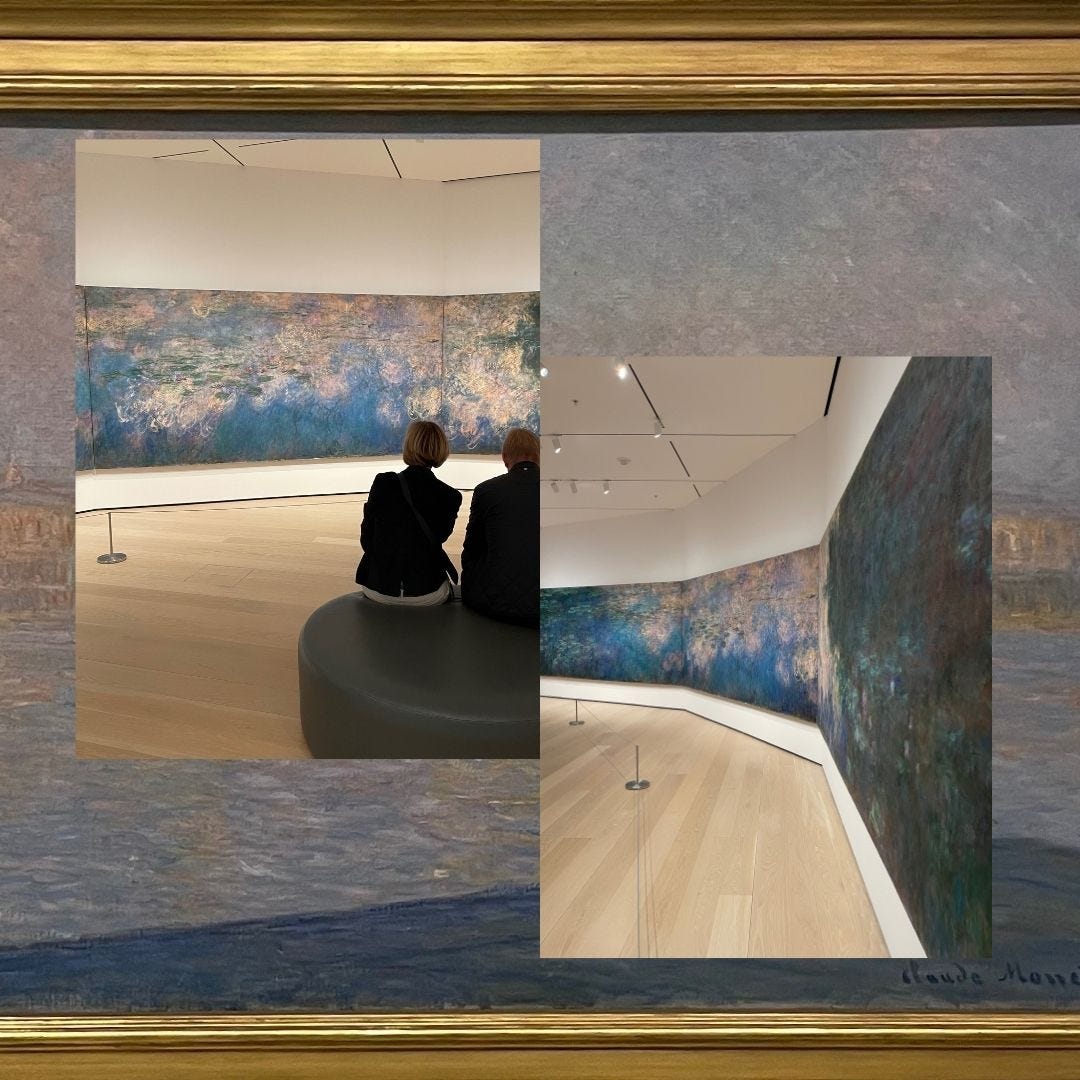
Why Monet’s Work Resonates with Me
As I mentioned earlier, there were many reasons why I was drawn to Monet’s work and how it evoked emotion for me through its use of light, its focus on nature, and its ability to capture fleeting moments. His work also embodies the idea of “looking” rather than merely “seeing,” which circles back to the art of truly observing. For those who are new here, in The Art of Looking: How to Read Modern and Contemporary Art, Lance Esplund invites us to approach art with openness, curiosity, and intuition rather than a rigid, analytical mindset. Esplund suggests that we engage with art on a personal and emotional level, experiencing it as a conversation rather than as a puzzle to be solved.
This perspective resonates deeply with me when I engage with Claude Monet’s works, particularly his Water Lilies series. Monet drew inspiration for this series from his garden in Giverny. These paintings, later gifted to France as a symbol of peace following World War I, seem to transcend their physical form, evoking a sense of timelessness and serenity.
Viewing Monet’s work through an emotional lens rather than a problem-solving approach allows me to explore why I am so captivated by his choice of colours, his brushwork, and the overall mood of his paintings. As I moved through the two rooms of the Musée d’Orangerie in Paris, I noticed how the series evolved. This progression prompts me to wonder whether Monet’s state of mind in his later years was one of grappling with the impermanence of life or perhaps finding solace in the act of painting itself. The haziness of the later paintings mirrors a world seen through blurred vision, yet they also evoke a dreamlike quality that feels deeply personal.
By embracing Esplund’s philosophy, I find that I engage with Monet’s work and other paintings, not just as a visual experience but as an emotional journey. It is in this act of looking, of being present, curious, and open, that I feel most connected to art and to the human emotions it embodies.

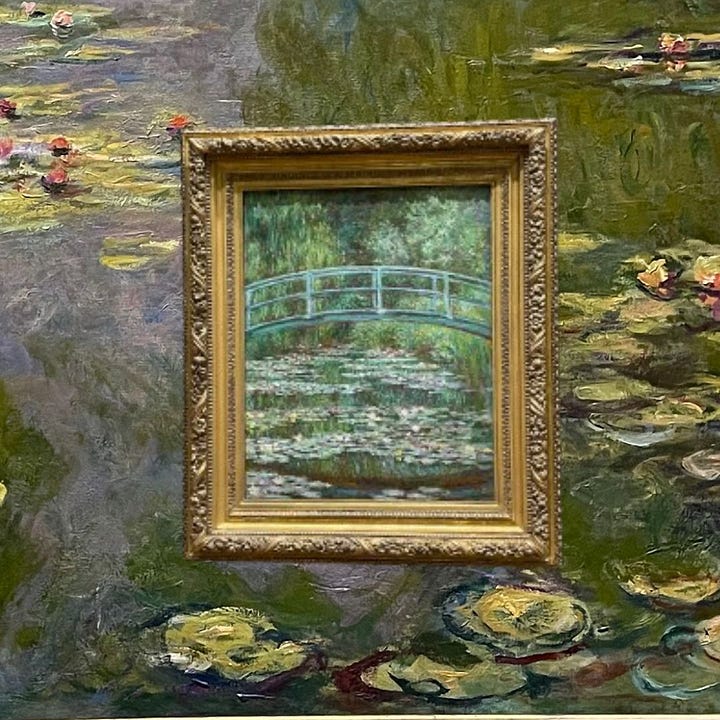
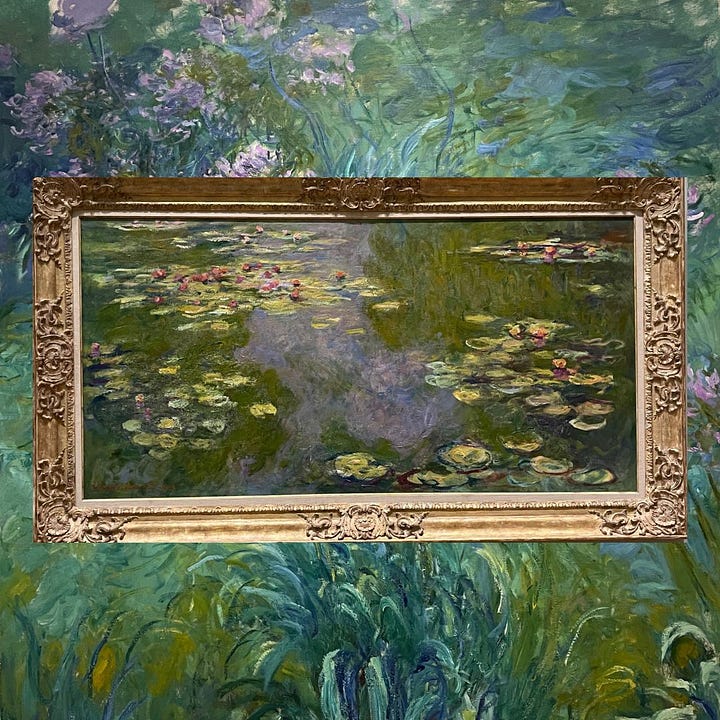
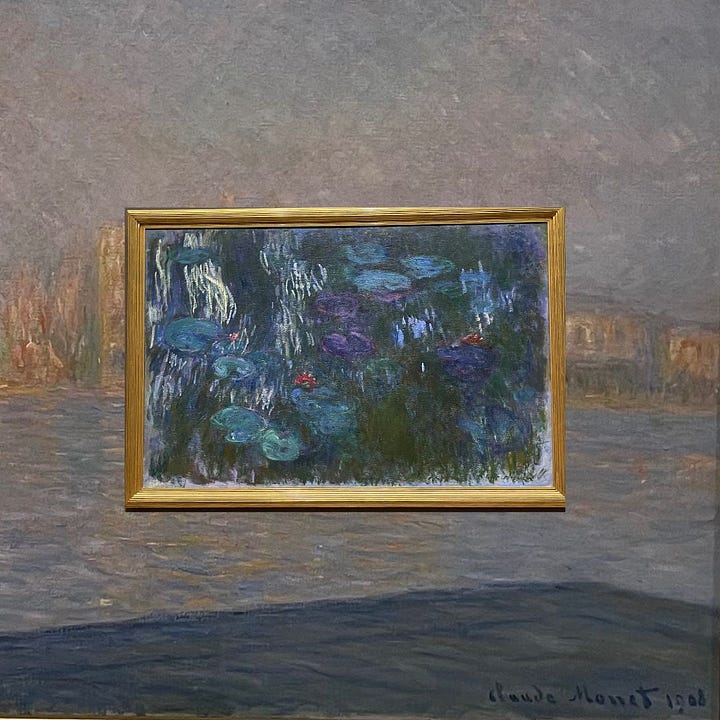
Monet, Impressionism, and Its Legacy
By abandoning the use of greys and black in shadows and opting for complementary colours instead, a technique pioneered by Monet, the Impressionist movement emerged from France in the 19th century. A group of artists organized an independent exhibition in Paris, marking a significant turning point. This revolution occurred because Impressionism broke away from the rigid, detailed, and highly polished techniques of academic painting that had dominated European art for centuries. Instead of focusing on historical, religious, or mythological subjects with perfect realism, Impressionists sought to capture the fleeting moments of everyday life, emphasizing light, colour, and movement. They rejected official exhibitions by organizing their shows, thereby challenging the established art system. The movement also offered a fresh perspective on reality by focusing on the artist’s perception rather than strict realism. Embracing modernity, Impressionism became a springboard for later avant-garde movements, including Post-Impressionism. Ultimately, Impressionism changed the way artists thought about colour, light, and perception, paving the way for modern art movements.
Since its inception in the 19th century, Impressionism has continued to influence contemporary art in various ways. In abstraction and expressionism, modern Impressionist works often lean toward abstraction, focusing on the overall visual effect rather than meticulous details. This approach marks a clear evolution from classic Impressionism to more expressive forms. Moreover, contemporary artists inspired by Impressionism are not limited to canvas and oil paints; they experiment with diverse media, including digital art, sculpture, and mixed media. In terms of installation art and environmental expression, contemporary Impressionism-inspired art incorporates global influences and perspectives, unlike the primarily France-centric original movement. For example, some artists channel Impressionist ideas into immersive experiences: Yayoi Kusama’s Infinity Rooms allow viewers to step into a world of shifting colours, lights, and movements, much like Impressionist paintings sought to do on canvas. Additionally, Impressionism has given rise to individualism and personal expression; modern artists, following the movement’s rebellious spirit, continue to emphasize personal expression and unique interpretations of their subjects, just as Ehiko does with her art.
Impressionism remains relevant today, not only in art but also in broader cultural and developmental contexts. Its core ideas, capturing fleeting moments, embracing subjectivity, and breaking away from rigid traditions, continue to shape how we see and engage with the world. In urban and social development, Impressionist ideals have profoundly influenced modern approaches, particularly in cities like Copenhagen and Amsterdam. These cities exemplify how prioritizing outdoor leisure, community engagement, and human-centred design can transform urban spaces into vibrant, inclusive environments.
Continuing with the topic of Impressionist ideals in urban and social development there is also, community engagement and local development. Impressionists celebrated ordinary life: workers, market scenes, and social gatherings. This aligns with bottom-up approaches in development, where communities, rather than elites, shape policies and initiatives. Such community engagement and local development initiatives, reminiscent of Impressionist ideals that celebrate everyday life and grassroots involvement, are evident in various countries. One notable example is Kenya, where community-led approaches have significantly influenced development policies and practices. One such organization is the Green Belt Movement (GBM), founded in 1977 by environmentalist Wangari Maathai, which empowers communities, particularly women, to conserve the environment and improve livelihoods through tree planting and sustainable practices.
Additionally, in terms of cultural memory and historical reflection, Impressionism documented a rapidly changing world marked by industrialization, urbanization, and shifting social structures. Similarly, today's artists and thinkers use Impressionist techniques and philosophies to reflect on contemporary issues such as globalization, gentrification, and cultural shifts. For example, Nigerian-born artist Fatimah Tuggar utilizes digital photomontage and video installations to juxtapose elements from African and Western daily life. Her art critiques power dynamics examines technology’s role in society and explores the effects of globalization. By blending traditional and modern imagery, Tuggar’s work challenges perceptions and highlights cultural intersections, resonating with the Impressionist focus on everyday experiences.
Connecting Back to Culture and Development
Claude Monet’s work, particularly his Water Lilies series and Impression, Sunrise, serves as a historical lens into France’s social and artistic transformation during the late 19th and early 20th centuries. His paintings capture the essence of industrialization, shifting urban landscapes, and the rise of leisure culture in France. His depictions of Paris, rural France, and the interplay of light reflect broader societal changes. Monet’s art is not just a visual delight; it’s a testament to France’s evolving identity, from its agrarian past to modernity.
Museums play a crucial role in ensuring that Impressionism remains accessible to the public. Institutions like the Musée d’Orsay in Paris, The Metropolitan Museum of Art in New York, and The National Gallery in London safeguard Monet’s legacy, offering insights into how his work influenced artistic evolution. These spaces also democratize access to art, enabling visitors to engage with Impressionism’s revolutionary techniques and themes. Through curatorial efforts, exhibitions, and conservation science, museums preserve not only the physical paintings but also the historical context that gives them meaning.
Monet’s art, like much of Impressionism, transcends national boundaries and continues to inspire global conversations on beauty, nature, and the passage of time. His technique of capturing fleeting moments mirrors modern discussions on ephemerality, environmentalism, and nostalgia. Impressionism encourages viewers to see the world differently, fostering cross-cultural exchanges on artistic expression and historical memory. Through contemporary exhibitions and digital platforms, Monet’s work remains a bridge between past and present, shaping how societies understand artistic heritage and its role in cultural identity.
Concluding Thoughts
To sum up, today’s post, while I remain captivated by Monet’s work and his impact on Impressionism, I see how changing our perception of viewing and consuming art allows us to connect with it emotionally rather than just objectively. We learn that through this movement, artists broke free from societal norms to express themselves creatively, a spirit that has transcended into contemporary and modern art today. Through Impressionism, we also see how its principles extend into the realm of development, influencing not only art but also the design of cities, the strategies of activist organizations, urbanization, and institutional practices. This reinforces my belief that all these disciplines are deeply connected.
My question of the week to my wonderful readers:
How has encountering art, changed the way you perceive beauty, nature, or even history?
Feel free to share your thoughts in the comments! and I will see you next week on Monday ( and not Wednesday hopefully!)


